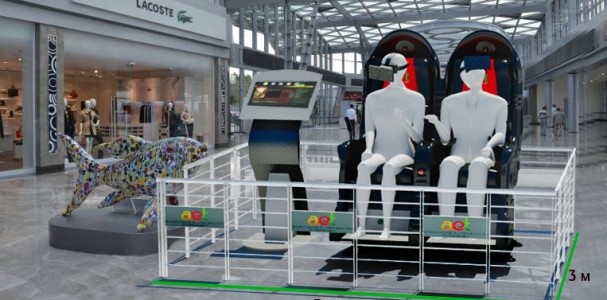The arcade industry was decimated back in the mid-90’s by the advancements in consumer console games as well as a failure to adapt to changing player demographics.
Virtual reality could bring it back.
As a side benefit, virtual reality arcades could help drive the development of the technology, whet public appetite for virtual reality games, and allow people to get used to wearing head-mounted displays.
In addition, since these kinds of applications are typically very short — a few minutes, at most — they sidestep the concerns of long exposure inducing simulation-sickness with some players.
It’s not just the arcades anymore
Today, you can find modern versions of arcade games far beyond the mall — in museums, in health clubs, in resorts, and in casinos.
The amusement trade has evolved into a far reaching entertainment sector which has become known as the Digital Out-of-Home Entertainment industry. Far from just focused on conventional arcade approach, interactive digital entertainment systems are covering a wide diversity of markets.
This diversity of markets is driving a new gold-rush, as the console and mobile game app industries find themselves in transition. And the skills of entertainment content creation are now being applied to the out-of-home sector since its link to a direct revenue model — pay-to-play — offers attractive opportunities for resources.
For virtual reality, the hunger for public-space entertainment platforms shows that the new virtual reality technology can be applied to re-invigorate the application of virtual reality entertainment as an out-of-home platform. While the majority of the virtual reality insurgence looks at consumer applications, the opportunity is building to profit from the popularity of virtual reality as a location-based entertainment platform — what some have called “virtual reality arcade.â€

Some executives suggest that the majority of players will not be able to embrace virtual reality at first due to high cost of the technology, or a reluctance to try something new. But virtual reality arcades, like the early video game centers before them, offer a means to jump into the experience in a low-cost, low-risk, socially inclusive environment.
Show me the money
Investment in this sector has already begun. Leading operators of location-based entertainment chains are looking at offering virtual reality to their customers.
One of the first to be revealed was the restaurant chain Dave & Buster’s, where customers at the Irvine, California location can now play the Dirt 3 racing game with the Oculus Rift.
Chuck E. Cheese’s, a childrens’ entertainment and restaurant chain, also rolled out a virtual reality attraction recently, called “Virtual Ticket Blaster,” which combines the chain’s existing “Ticket Blaster” game — where children stand in a booth and try to catch paper tickets — with a virtual reality environment.
Real tickets awarded for those collected in the virtual environment. The system is being tested this month in Dallas, and will be rolled out to San Diego and Orlando later.
Beyond these experimental platforms, attraction developers are taking the plunge and replacing the traditional large screens of enclosed 4D theaters with virtual reality headsets to offer a new level of immersive entertainment.
Amusement & Edutainment Technologies recently launched their “Motion Sphere,” which combines a two-seat dynamic motion platform with a virtual reality headset. The company says this hardware is perfect for shopping malls and amusement venues, offering both unique entertainment and a popular audience experience. How AET will develop content for their platform is yet to be revealed, though it is expected they will build off of their extensive knowledge in developing 4D ride films now for virtual viewers.
Waiting on software
The successful application of virtual reality in public venues depends on several factors. One is the need for dedicated technology specifically designed for this purpose.
The headsets, for example, will need to be extra durable, and some vendors are already working on creating rugged and robust head mounted displays.
Out-of-home systems can also offer much more powerful computer systems, to create a level of performance and physical effects that is unachievable in consumer platforms.
And, as with the 3D cinema industry, the issues of hygiene and reliability will need to be effectively surmounted.
- Virtual reality could find its first home outside the home - May 29, 2014
